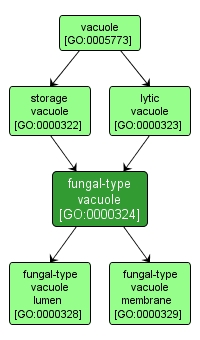GO TERM SUMMARY
|
| Name: |
fungal-type vacuole |
| Acc: |
GO:0000324 |
| Aspect: |
Cellular Component |
| Desc: |
A vacuole that has both lytic and storage functions. The fungal vacuole is a large, membrane-bounded organelle that functions as a reservoir for the storage of small molecules (including polyphosphate, amino acids, several divalent cations (e.g. calcium), other ions, and other small molecules) as well as being the primary compartment for degradation. It is an acidic compartment, containing an ensemble of acid hydrolases. At least in S. cerevisiae, there are indications that the morphology of the vacuole is variable and correlated with the cell cycle, with logarithmically growing cells having a multilobed, reticulated vacuole, while stationary phase cells contain a single large structure. |
Synonyms:
- vacuole, cell cycle-correlated morphology
|
|

|
INTERACTIVE GO GRAPH
|














